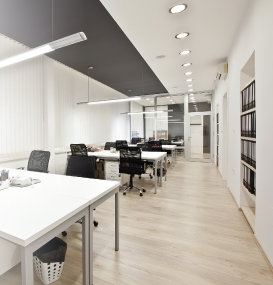
Design considerations when building and outfitting office spaces
Office furniture retailer Slingsby walks us through some important aspects of designing a workplace.
 Ergonomics are an important part of the design process for architects and interior designers alike.
Ergonomics are an important part of the design process for architects and interior designers alike.
When it comes to offices, there are few things more important than selecting the right office plan and the right seating for those who will eventually occupy the building.
Office seating
The NHS reported that the most common office problem is back pain, which is brought on through poor posture. Seating is a key factor when it comes to improving posture. Chairs should support a user’s back, offering reinforcement in the weaker lower portion of your back. They should be tall enough to keep knees level with hips. They should also allow a user to keep their feet flat to the floor.
When kitting out any new office space, you should select chairs from the following list.
Operator chairs – designed for heavy keywboard use over long periods, this style of chair comes in useful for a computer heavy office. They have medium to high backs that support all of the back and shoulders and have optional arms.
Typist chairs – Similar to operator chairs, the typist chair tends to have a lower back to support the lower section of a person’s spine. They do not recline as much as operator chairs and promote good posture through their lower range of motion.
24 hour seating – Designed for constant use throughout the day, 24 hour chairs are reinforced versions of the operator chair. Good for offices that may be used as call centres or other 24 hour centres (hospital receptions etc.)
High Back Chairs – Good for extensive work when seated, the back of the chair can be extended up to the shoulders to support the head and neck.
Ergonomic Chairs – These are designed for long-lasting comfort, support and increasing the quality of work. Fully adjustable and perfect for preventing back pain and promoting posture, but usually more expensive than other chairs.
However, you may want to consider stand-up desks if you’re designing a small office that may be used by a start-up or small business.
Office space layout
When planning an office it’s vital to consider whether you’ll design an open plan or a more cubicle-led office space. Open plan offices are more popular in creative sectors and encourage staff communication, so if you’re aiming to lease space to more creative industries this is the way to go. However, they’re also prone to spreading disease and lowering productivity at times – so choose carefully.
A good option is to create a layout that caters to open plan design, but allows for optional cubicles to be installed.
If you take these factors into consideration when designing an office space, you’re more likely to find tenants or sell the building as worker satisfaction is an important aspect for most businesses. Including seating also reduces the overall cost for a company moving into the building, which makes your design more attractive.
Link for more information from Slingsby – your workplace partner
Otley Road,
Baildon, Shipley,
BD17 7LW
Tel + 44 (0)1274 535030
Fax + 44 (0)1274 535033
Visit Supplier's page
Latest news

21st February 2025
ASSA ABLOY EMEIA: Save valuable time and money with a seamless switch to programmable digital keys
In 2025, access management can be a whole lot easier. By making access part of their digital processes, businesses can put time-consuming key management and the cost of changing the locks firmly behind them. Making this switch is a lot easier than many people think, as ASSA ABLOY explains here…
Posted in Access Control & Door Entry Systems, Architectural Ironmongery, Articles, Building Industry News, Building Products & Structures, Building Services, Doors, Facility Management & Building Services, Health & Safety, Information Technology, Innovations & New Products, Retrofit & Renovation, Security and Fire Protection
21st February 2025
Showersave supports industry leaders in addressing Part L and Part G regulations
Showersave has sponsored and participated in a recent Building Insights LIVE roundtable on ‘Water & Energy Saving Innovations in New Build Housing’.
Posted in Articles, Bathrooms & Toilets, Bathrooms, Bedrooms & Washrooms, Building Associations & Institutes, Building Industry Events, Building Industry News, Building Products & Structures, Building Regulations & Accreditations, Building Services, Exhibitions and Conferences, Interiors, Pipes & Fittings, Plumbing, Retrofit & Renovation, Sustainability & Energy Efficiency
21st February 2025
GEZE: The importance of Specifying High Quality Door Closers on Fire Doors
Andy Howland, Sales & Marketing Director at GEZE UK, discusses why specifying high quality door closers on fire doors is important…
Posted in Access Control & Door Entry Systems, Accessibility, Architectural Ironmongery, Articles, Building Industry News, Building Products & Structures, Building Regulations & Accreditations, Building Services, Doors, Facility Management & Building Services, Health & Safety, Posts, Restoration & Refurbishment, Retrofit & Renovation, Security and Fire Protection
21st February 2025
Insight Data achieves ISO9001 recertification with zero non-conformities
Leading industry data specialist, Insight Data, has successfully achieved the prestigious recertification for ISO9001 with zero non-conformities for the fourth consecutive year.
Posted in Articles, Building Industry News, Building Regulations & Accreditations, Building Services, Information Technology, Research & Materials Testing
 Sign up:
Sign up: